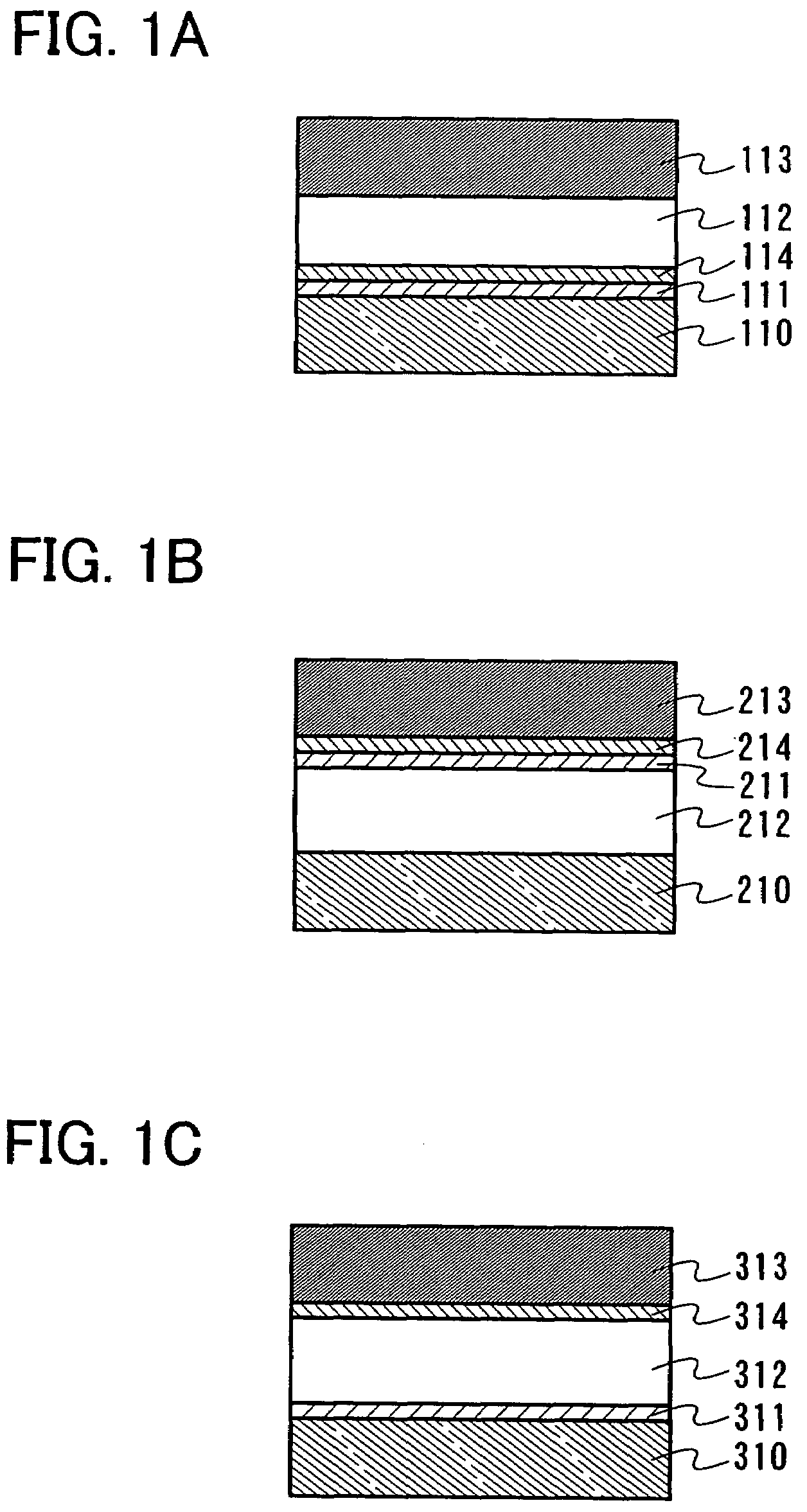Semiconductor device with metal oxides and an organic compound
a technology of metal oxides and semiconductors, applied in thermoelectric devices, bulk negative resistance effect devices, instruments, etc., can solve the problems of difficult preventing crosstalk and needing to solve passive matrix elements, and achieve the effect of high integration and exceptionally low manufacturing costs per memory elemen
- Summary
- Abstract
- Description
- Claims
- Application Information
AI Technical Summary
Benefits of technology
Problems solved by technology
Method used
Image
Examples
embodiment mode 1
[0046]In the present embodiment mode, an example of a manufacturing method of a passive matrix memory device that has a plurality of memory elements over a glass substrate, which is one kind of a substrate that has an insulating surface, will be explained using FIG. 1A. FIG. 1A is a cross-sectional view schematic diagram of one memory element.
[0047]First, over a glass substrate, a first electrode 110 is formed as shown in FIG. 1A. The first electrode 110 can be formed as a single-layer or multilayer structure. Specifically, a film of elemental aluminum (Al), titanium (Ti), molybdenum (Mo), tungsten (W), a film of an alloy using one or more of any of these elements, a film of an alloy of one or more of any of these elements and silicon, or the like can be used. Alternatively, a light-transmitting material such as indium-tin oxide (ITO), indium-tin oxide containing silicon oxide, indium oxide containing from 2 wt % to 20 wt % of zinc oxide, or the like can also be used.
[0048]It is to ...
embodiment mode 2
[0054]In Embodiment Mode 1, an example is given of a memory element in which metal oxide layers are stacked to form a p-n junction and a layer containing an organic compound over the stacked layers. In the present embodiment mode, an example will be given of a memory element that has a first metal oxide layer and a second metal oxide layer stacked over a layer that contains an organic compound in such a way that a p-n junction is formed.
[0055]First, over a glass substrate, as in Embodiment Mode 1, a first electrode 210 is formed as shown in FIG. 1B.
[0056]Next, a partition is provided to separate neighboring memory elements, that is, neighboring first electrodes 210. In the present embodiment mode, the partition is provided; however, the partition need not necessarily be used.
[0057]Next, a layer 212 that contains an organic compound is formed over the first electrode 210. The layer 212 that contains an organic compound can be formed by an evaporation method, a spin coating method, a ...
embodiment mode 3
[0063]In the present embodiment mode, an example of a memory element is shown in which a layer that contains an organic compound is provided over a first metal oxide layer, and a second metal oxide layer is provided over the layer that contains an organic compound.
[0064]First, over a glass substrate, as in Embodiment Mode 1, a first electrode 310 is formed as shown in FIG. 1C.
[0065]Next, a partition is provided to separate neighboring memory elements, that is, neighboring first electrodes 310.
[0066]Next, a first metal oxide layer 311 that functions as a p-type semiconductor material is formed over the first electrode 310.
[0067]Then, a layer 312 that contains an organic compound is formed over the first metal oxide layer 311.
[0068]After that, a second metal oxide layer 314 that functions as an n-type semiconductor material is formed over the layer 312 that contains an organic compound.
[0069]In the present embodiment mode, because the layer 312 that contains an organic compound is for...
PUM
| Property | Measurement | Unit |
|---|---|---|
| thickness | aaaaa | aaaaa |
| thickness | aaaaa | aaaaa |
| thickness | aaaaa | aaaaa |
Abstract
Description
Claims
Application Information
 Login to View More
Login to View More - R&D
- Intellectual Property
- Life Sciences
- Materials
- Tech Scout
- Unparalleled Data Quality
- Higher Quality Content
- 60% Fewer Hallucinations
Browse by: Latest US Patents, China's latest patents, Technical Efficacy Thesaurus, Application Domain, Technology Topic, Popular Technical Reports.
© 2025 PatSnap. All rights reserved.Legal|Privacy policy|Modern Slavery Act Transparency Statement|Sitemap|About US| Contact US: help@patsnap.com



